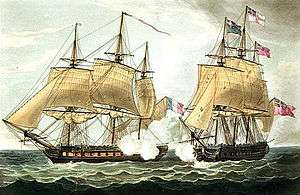French frigate Clorinde (1808)
Clorinde was a 40-gun Pallas-class frigate of the French Navy, designed by Sané. The British Royal Navy captured her in 1814 and renamed her HMS Aurora. After 19 years as a coal hulk she was broken up in 1851.
 Clorinde fighting HMS Eurotas | |
| History | |
|---|---|
| Name: | Clorinde |
| Namesake: | Clorinda |
| Laid down: | 19 July 1806 |
| Launched: | 1808 |
| Captured: | 26 February 1814 |
| Name: | Aurora |
| Acquired: | 26 February 1814 |
| Fate: | Broken up on 24 April 1851 |
| General characteristics | |
| Class and type: | Pallas-class frigate |
| Displacement: | 1,080 tonnes |
| Length: | 46.93 m (154 ft 0 in) |
| Beam: | 11.91 m (39 ft 1 in) |
| Draught: | 5.9 m (19 ft 4 in) |
| Propulsion: | 1,950 m2 (21,000 sq ft) of sail |
| Complement: | 326 |
| Armament: |
|
French frigate
From June 1809, she was stationed with the 16-gun Milan and the 38-gun Renommée. In September, she sailed with Renommée, Loire, and Seine to Guadeloupe. On 13 December, she and Renommée captured HMS Junon.[1]
On 15 December 1809, Clorinde ran aground, and freed herself by dropping guns and ammunition overboard.
She took part in the Action of 20 May 1811, fought off Madagascar, and returned to Brest. Captain Jacques Saint-Cricq was found guilty of failing to properly support his commodore, and demoted of rank, expelled from the Legion of Honour, and sentenced to three years in prison.
On 6 December 1813, Clorinde captured the British merchant vessel Lusitania in the Atlantic Ocean (44°30′N 10°30′W). Lusitania, Johnston, master, had been sailing from London to Suriname. Clorinde then put the crews of four other vessels that she had captured aboard Lusitania and sent her into Plymouth. The other four were:
- Blenden Hall, of 473 tons (bm), Barr, master, which had been sailing from London to Bermuda;
- John O'Gaunt, of 426 tons (bm), P. Inglis, master, which had been sailing from London to Martinique;
- Aurora, Scheidt, master, which had been sailing to Amelia Island; and,
- Superb, R. Roberts, of 130 tons (bm), which had been sailing from Gibraltar to England.
Clorinde abandoned Blenden Hall at sea, where the Falmouth packet Eliza, homeward bound from Malta, found her floating. HMS Challenger brought Blenden Hall into Plymouth. They arrived on 19 December, on the same day as Lusitania.[2]
On 18 February 1814 Clorinde captured the Post Office Packet Service packet Townshend, Captain James Cock, at 48°30′N 9°00′W. Although Captain Denis Lagarde,[3] flew Portuguese colours in an attempt to trick Cock, Cock surmised that the frigate was French, not Portuguese, and threw his mails overboard before the Frenchmen boarded Townshend. Clorinde sank Townshend.[4]
On 25 February 1814, at 47°40′N 9°30′W, the 38-gun HMS Eurotas chased Clorinde.[5] A violent fight ensued for two hours and 20 minutes that left both ships dismasted, Eurotas suffering 20 killed and 30 wounded (including Captain John Phillimore), and Clorinde, 40 killed and 80 wounded. During the night, the ships built jury rigs and resumed the pursuit the next day, when HMS Dryad and HMS Achates intervened. The helpless Clorinde struck after the first cannon shot from Dryad, which towed Clorinde into Portsmouth.
British frigate
Clorinde was brought into British service as HMS Aurora.[6] She served off South America during the years 1821–25,[7] and in the Caribbean, 1826–28.[8]
Fate
From January 1832, she was used as a coal hulk in Falmouth. She was eventually broken up in May 1851.
Citations and references
Citations
- HMS Junon, naval database
- Lloyd's List №4831. Accessed 3 December 2016.
- Notice Biographique, René Joseph Marie Denis-Lagarde
- Howat (1984), p. 17.
- HMS Eurotas, Naval database
- HMS Aurora, Naval database
- A Frigate of King George, Brian Vale, 2001
- http://www.pbenyon.plus.com/18-1900/A/00403.html
References
- Howat, J.N.T. (1984). South American packets: the British packet service to Brazil, the River Plate, the West Coast (via the Straits of Magellan), and the Falkland Islands, 1808-80. York, England: Postal History Society in Association with William Sessions. ISBN 0900657952.
- Roche, Jean-Michel (2005). Dictionnaire des bâtiments de la flotte de guerre française de Colbert à nos jours 1 1671 - 1870. ISBN 978-2-9525917-0-6. OCLC 165892922.